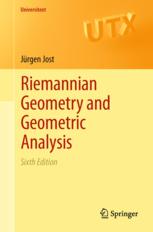目录
Preface
Contents
Chapter 1: Riemannian Manifolds
1.1 Manifolds and Differentiable Manifolds
1.2 Tangent Spaces
1.3 Submanifolds
1.4 Riemannian Metrics
1.5 Existence of Geodesics on Compact Manifolds
1.6 The Heat Flow and the Existence of Geodesics
1.7 Existence of Geodesics on Complete Manifolds
Exercises for Chapter 1
Chapter 2: Lie Groups and Vector Bundles
2.1 Vector Bundles
2.2 Integral Curves of Vector Fields. Lie Algebras
2.3 Lie Groups
2.4 Spin Structures
Exercises for Chapter 2
Chapter 3: The Laplace Operator and Harmonic Differential Forms
3.1 The Laplace Operator on Functions
3.2 The Spectrum of the Laplace Operator
3.3 The Laplace Operator on Forms
3.4 Representing Cohomology Classes by Harmonic Forms
3.5 Generalizations
3.6 The Heat Flow and Harmonic Forms
Exercises for Chapter 3
Chapter 4: Connections and Curvature
4.1 Connections in Vector Bundles
4.2 Metric Connections. The Yang–MillsFunctional
4.3 The Levi-Civita Connection
4.4 Connections for Spin Structures and the Dirac Operator
4.5 The Bochner Method
4.6 Eigenvalue Estimates by the Method of Li–Yau
4.7 The Geometry of Submanifolds
4.8 Minimal Submanifolds
Exercises for Chapter 4
Chapter 5: Geodesics and Jacobi Fields
5.1 First and second Variation of Arc Length and Energy
5.2 Jacobi Fields
5.3 Conjugate Points and Distance Minimizing Geodesics
5.4 Riemannian Manifolds of Constant Curvature
5.5 The Rauch Comparison Theorems and Other Jacobi Field Estimates
5.6 Geometric Applications of Jacobi Field Estimates
5.7 Approximate Fundamental Solutions and Representation Formulas
5.8 The Geometry of Manifolds of Nonpositive Sectional Curvature
Exercises for Chapter 5
A Short Survey on Curvature and Topology
Chapter 6: Symmetric Spaces and Kähler Manifolds
6.1 Complex Projective Space
6.2 Kähler Manifolds
6.3 The Geometry of Symmetric Spaces
6.4 Some Results about the Structure of Symmetric Spaces
6.5 The Space Sl(n, R)/SO(n, R)
6.6 Symmetric Spaces of Noncompact Type
Exercises for Chapter 6
Chapter 7: Morse Theory and Floer Homology
7.1 Preliminaries: Aims of Morse Theory
7.2 The Palais–Smale Condition, Existence of Saddle Points
7.3 Local Analysis
7.4 Limits of Trajectories of the Gradient Flow
7.5 Floer Condition, Transversality and Z2-Cohomology
7.6 Orientations and Z-homology
7.7 Homotopies
7.8 Graph flows
7.9 Orientations
7.10 The Morse Inequalities
7.11 The Palais–Smale Condition and the Existence of Closed Geodesics
Exercises for Chapter 7
Chapter 8: Harmonic Maps between Riemannian Manifolds
8.1 Definitions
8.2 Formulas for Harmonic Maps. The Bochner Technique
8.3 The Energy Integral and Weakly Harmonic Maps
8.4 Higher Regularity
8.5 Existence of Harmonic Maps for Nonpositive Curvature
8.6 Regularity of Harmonic Maps for Nonpositive Curvature
8.7 Harmonic Map Uniqueness and Applications
Exercises for Chapter 8
Chapter 9: Harmonic Maps from Riemann Surfaces
9.1 Two-dimensional Harmonic Mappings
9.2 The Existence of Harmonic Maps in Two Dimensions
9.3 Regularity Results
Exercises for Chapter 9
Chapter 10: Variational Problems from Quantum Field Theory
10.1 The Ginzburg–Landau Functional
10.2 The Seiberg–Witten Functional
10.3 Dirac-harmonic Maps
Exercises for Chapter 10
A Linear Elliptic Partial Differential Equations
A.1 Sobolev Spaces
A.2 Linear Elliptic Equations
A.3 Linear Parabolic Equations
B Fundamental Groups and Covering Spaces
Bibliography
Index
【展开】
【收起】
内容简介
This established reference work continues to lead its readers to some of the hottest topics of contemporary mathematical research. The previous edition already introduced and explained the ideas of the parabolic methods that had found a spectacular success in the work of Perelman at the examples of closed geodesics and harmonic forms. It also discussed further examples of geometric variational problems from quantum field theory, another source of profound new ideas and methods in geometry.
The 6th edition includes a systematic treatment of eigenvalues of Riemannian manifolds and several other additions. Also, the entire material has been reorganized in order to improve the coherence of the book.
From the reviews:
"This book provides a very readable introduction to Riemannian geometry and geometric analysis. ... With the vast development of the mathematical subject of geometric analysis, the present textbook is most welcome." Mathematical Reviews
"...the material ... is self-contained. Each chapter ends with a set of exercises. Most of the paragraphs have a section ‘Perspectives’, written with the aim to place the material in a broader context and explain further results and directions." Zentralblatt MATH
【展开】
【收起】
下载说明
1、追日是作者栎年创作的原创作品,下载链接均为网友上传的的网盘链接!
2、相识电子书提供优质免费的txt、pdf等下载链接,所有电子书均为完整版!
下载链接
